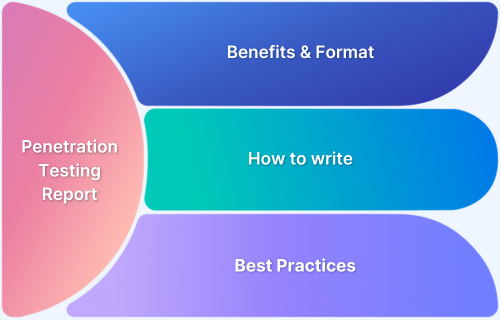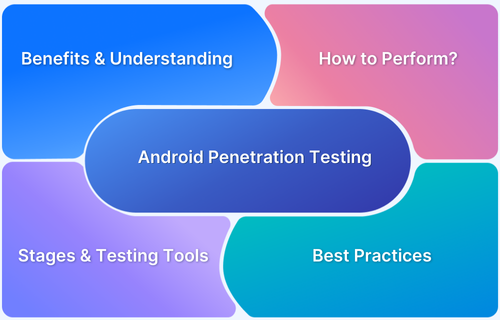Understanding Cloud Penetration Testing
By Sourojit Das, Community Contributor - December 19, 2024
Penetration testing, also known as “pen testing” or “ethical hacking”, is a proactive security assessment methodology designed to identify and address security vulnerabilities and weaknesses within a target system or infrastructure. The primary objective of penetration testing is to simulate real-world attacks and assess an organisation’s security measures.
This article explains in detail cloud penetration testing, its benefits, challenges, types, and more.
- What is Cloud Penetration Testing?
- Difference between Penetration Testing and Cloud Penetration Testing
- How does Cloud Penetration Testing work
- Challenges in Cloud Penetration Testing
- Benefits of Cloud Penetration Testing
- Different Cloud Penetration Testing Methods
- Cloud Penetration Testing Tools
- Cloud Penetration Testing Best Practices
What is Cloud Penetration Testing?
Cloud penetration testing, also known as cloud security testing or cloud vulnerability assessment, is the process of evaluating the security of cloud-based systems and infrastructure to identify potential vulnerabilities and weaknesses. The goal of cloud penetration testing is to simulate real-world attacks and provide insights into the security posture of the cloud environment.
Difference between Penetration Testing and Cloud Penetration Testing
The primary difference between penetration testing (pentesting) and cloud penetration testing lies in the focus of the testing process:
| Penetration Testing | Cloud Penetration Testing |
|---|---|
| 1. Pentesting, also known as ethical hacking, is a security assessment methodology that involves evaluating the security of an organisation’s IT systems, networks, applications, and devices. | 1. Cloud penetration testing, on the other hand, is a specialised form of penetration testing that specifically focuses on evaluating the security of cloud-based systems and services. |
| 2. Pentesting can be applied to both on-premises and cloud-based environments, making it a more general and broader term. The scope of traditional pentesting includes a wide range of targets, such as internal networks, external-facing systems, web applications, mobile applications, databases, and physical security measures. | 2. It is tailored to assess the security of cloud computing environments and addresses the unique security challenges presented by cloud service models (IaaS, PaaS, SaaS) and cloud providers. Cloud penetration testing includes evaluating the security of cloud-hosted virtual machines, containers, cloud storage, cloud databases, serverless applications, APIs, and various cloud-specific services. |
In summary, while both pentesting and cloud penetration testing aim to identify security vulnerabilities, the difference lies in the specific focus of cloud penetration testing on cloud-based systems and services, taking into account the cloud-specific security challenges and shared responsibility model. Cloud penetration testing is a specialised form of penetration testing designed to meet the unique security needs of cloud environments.
Read More: Why DevOps Teams Need Cloud-Based Solutions
How does Cloud Penetration Testing work
Cloud penetration testing involves the following steps:
- Planning and Scoping: Determine the scope of the penetration test, including which cloud services, applications, and data will be tested. Understand the objectives of the test and any specific compliance requirements that need to be met.
- Reconnaissance: Gather information about the target cloud environment, such as IP ranges, subdomains, cloud provider-specific services, and other publicly available information that can be used to identify potential attack vectors.
- Vulnerability Assessment: Conduct a vulnerability scan to identify known security weaknesses in the cloud infrastructure, applications, and services.
- Exploitation: Attempt to exploit the identified vulnerabilities to gain unauthorized access to the cloud resources. This may involve attempting to bypass authentication mechanisms, exploiting misconfigurations, or leveraging known vulnerabilities.
- Privilege Escalation: Once initial access is gained, the penetration tester may attempt to escalate privileges to gain higher levels of access within the cloud environment.
- Data Exfiltration: In some cases, the penetration tester may attempt to extract sensitive data from the cloud environment to demonstrate the impact of a successful attack.
- Reporting: Document all findings, including identified vulnerabilities, their potential impact, and recommended remediation measures. The report should be detailed and actionable, allowing the organization to address the security issues effectively.
- Remediation and Follow-Up: Work with the organization’s IT and security teams to address the identified vulnerabilities and verify that the remediation actions are effective.
Challenges in Cloud Penetration Testing
Before proceeding with Cloud Penetration testing, be aware of these most common challenges in it:
1. Legal and Compliance Barriers
Penetration tests in cloud environments often require explicit authorization from cloud providers, as unauthorized testing can result in legal consequences.
Each provider (for example, AWS, Azure, GCP) has specific rules governing what can be tested. Additionally, data privacy regulations like GDPR and HIPAA impose restrictions on accessing sensitive data, complicating the testing process.
2. Shared Responsibility Model
Cloud security operates under a shared responsibility model, where the provider manages infrastructure security, and the customer secures their applications and data.
This division often limits pen-testers to customer-managed layers, creating blind spots in the overall security posture.
3. Complexity of Multi-Cloud and Hybrid Environments
Organizations using multiple cloud providers or hybrid environments face challenges in managing diverse architectures, configurations, and permissions.
Testing such environments requires advanced tools and expertise to address the complexity of interconnected systems and data flows.
4. Dynamic Cloud Assets
Cloud environments are highly dynamic, with assets like containers and virtual machines being spun up and down frequently.
This rapid change makes it difficult to map and test the entire attack surface. Ephemeral assets, in particular, may disappear before they can be fully assessed.
5. Limited Testing Permissions
Cloud providers often impose strict restrictions on penetration tests to protect shared infrastructure. Pentesters may only be allowed to test certain components within predefined boundaries, such as specific IP ranges or bandwidth limits, which can limit the scope of the test.
6. Cloud-Native Services and Architectures
Cloud-native applications rely heavily on services like serverless computing, containers, and managed databases, which require tailored testing approaches.
Traditional pentesting methods may not effectively address the unique security challenges of these services. Additionally, APIs, a key component of cloud-native architectures, require specialized expertise for security assessment.
Read More: What is API Testing?
7. Tool Limitations and False Positives
Many penetration testing tools are not optimized for cloud environments, leading to incomplete scans or inaccurate results. Automated tools can also generate numerous false positives, requiring significant manual effort to validate vulnerabilities.
8. Cost Implications
Penetration testing in cloud environments can incur unexpected costs due to resource consumption, such as bandwidth, storage, and compute usage.
Additionally, conducting thorough testing in large and complex environments can be expensive, particularly when specialized tools or expertise are required.
9. Advanced Threat Simulation Challenges
Simulating advanced persistent threats (APTs) or insider attacks in cloud environments is complex and requires deep expertise.
Cloud providers’ monitoring and intrusion detection systems can prematurely block or interfere with testing activities, making it harder to replicate real-world attack scenarios effectively.
Benefits of Cloud Penetration Testing
Cloud penetration testing offers several significant benefits to organizations that leverage cloud services. Some of the key advantages include:
- Identifying Vulnerabilities: Cloud penetration testing helps in identifying potential security vulnerabilities and weaknesses in the cloud infrastructure, applications, and services. It allows organizations to proactively discover and address security flaws before malicious actors can exploit them.
- Assessing Cloud-Specific Risks: Cloud environments have unique security challenges due to shared responsibility models, complex configurations, and different service models (IaaS, PaaS, SaaS). Penetration testing tailored to the cloud helps in evaluating risks specific to cloud deployments.
- Compliance and Regulatory Requirements: Many industries and jurisdictions have strict compliance and data protection regulations. Conducting cloud penetration testing helps organizations meet regulatory requirements and demonstrate their commitment to maintaining robust security measures.
- Validating Cloud Provider Security: Cloud providers implement various security measures, but it’s essential for organizations to verify these claims independently. Penetration testing allows organizations to assess the effectiveness of the security controls implemented by their cloud service providers.
- Enhancing Incident Response Preparedness: By simulating real-world attack scenarios, cloud penetration testing helps organizations improve their incident response capabilities. The exercise provides valuable insights into how the organization responds to and detects security incidents.
- Minimizing Downtime and Losses: Addressing vulnerabilities before they are exploited reduces the likelihood of system downtime, data breaches, and potential financial losses resulting from security incidents.
- Improving Security Awareness: Penetration testing raises awareness among employees and stakeholders about the importance of security best practices. It can lead to a more security-conscious culture within the organization.
- Risk Prioritization and Resource Allocation: Penetration testing reports provide a clear picture of the most critical security risks. This allows organizations to prioritize their resources and efforts on fixing the most severe vulnerabilities.
- Third-Party Assessment: Cloud penetration testing can be valuable when dealing with third-party vendors or partners. Organizations can ensure that their data is secure when interacting with external cloud services or integrating with other cloud-based systems.
- Adapting to Changing Threat Landscape: The cybersecurity landscape is constantly evolving. Regular cloud penetration testing helps organisations stay ahead of new threats and vulnerabilities that may emerge in the cloud environment.
Overall, cloud penetration testing is an integral part of a comprehensive cloud security strategy. It provides organisations with valuable insights into their cloud security posture, enabling them to take proactive steps to protect their data, applications, and infrastructure from potential cyber threats.
Read More: How to write a good Test Summary Report?
Different Cloud Penetration Testing Methods
Cloud penetration testing employs various methods and techniques to assess the security of cloud environments effectively. Here are some common methods used in cloud penetration testing:
- White Box Testing: In white box testing, the penetration tester has full knowledge of the cloud environment’s internal structure, architecture, and configurations. This approach allows for a thorough analysis of the system’s security, including potential misconfigurations and weak points.
- Black Box Testing: In contrast to white box testing, black box testing involves simulating an attack without any prior knowledge of the cloud environment’s internal details. This method helps replicate real-world scenarios where an external attacker attempts to breach the system.
- Grey Box Testing: Grey box testing is a combination of white box and black box testing. The penetration tester has partial knowledge of the cloud environment, typically with limited access to certain areas of the system. This method strikes a balance between realism and the ability to focus efforts on specific areas of interest.
- Automated Scanning: Automated scanning tools are used to perform vulnerability assessments and identify common security issues across the cloud environment quickly. These tools can help discover misconfigurations, open ports, outdated software, and known vulnerabilities in cloud services.
- Manual Testing: Manual testing involves skilled penetration testers who use their expertise and experience to identify complex vulnerabilities and potential attack vectors that automated tools might miss. Manual testing allows for creative and adaptive approaches to uncover security weaknesses.
- Social Engineering: Social engineering involves testing the human element of the cloud environment by attempting to manipulate individuals into divulging sensitive information or granting unauthorized access. This could be through methods like phishing emails or phone calls.
- Exploitation of Known Vulnerabilities: Penetration testers leverage known vulnerabilities to exploit the cloud environment. This method assesses the impact of unpatched or outdated software and services that attackers might target.
- Brute Force Attacks: In brute force attacks, penetration testers attempt to gain unauthorized access by systematically trying all possible combinations of usernames and passwords or other authentication mechanisms.
- Privilege Escalation: This technique involves trying to escalate privileges from a lower-level user to gain higher-level access within the cloud environment. It helps evaluate the effectiveness of access controls.
- Data Exfiltration: Penetration testers may attempt to extract sensitive data from the cloud environment to demonstrate the impact of a successful attack and the potential consequences of a data breach.
- Denial of Service (DoS) Testing: This method assesses the cloud infrastructure’s resilience against denial-of-service attacks, which aim to disrupt or degrade the availability of cloud services.
It’s important to note that the selection of specific testing methods depends on the organization’s goals, the cloud service model (IaaS, PaaS, SaaS), the scope of the penetration test, and the level of access granted to the penetration testers.
A combination of these methods is often used to provide comprehensive coverage in cloud penetration testing. Additionally, it’s crucial to conduct cloud penetration testing ethically and with proper authorization to avoid any negative impact on the cloud services and data.
Also Read: Guide to Android Penetration Testing
Cloud Penetration Testing Tools
Cloud penetration testing requires a mix of general penetration testing tools and cloud-specific tools to effectively assess the security of cloud environments. Here are some popular cloud pentesting tools that security professionals commonly use:
1. Nmap:
Nmap is a versatile and widely used network scanning tool that helps in discovering hosts and services on a network, including cloud-based environments.
2. Burp Suite:
Burp Suite is a powerful web application security testing tool that assists in identifying and exploiting vulnerabilities in web applications and APIs hosted in the cloud.
3. OWASP ZAP:
ZAP (Zed Attack Proxy) is an open-source web application security scanner that helps in identifying security vulnerabilities in web applications deployed on the cloud.
4. Metasploit:
Metasploit is a popular penetration testing framework that aids in identifying and exploiting vulnerabilities in various systems, including cloud-based services.
5. SQLMap:
SQLMap is a tool designed to detect and exploit SQL injection vulnerabilities in web applications and APIs hosted on cloud platforms.
The selection of tools may vary depending on the specific cloud service provider and the cloud deployment model (public, private, hybrid) being tested. Always ensure you are familiar with the tools you use and their impact on the cloud environment before conducting any penetration testing activities.
Cloud Penetration Testing Best Practices
Cloud penetration testing requires careful planning, execution, and consideration of cloud-specific factors. Here are some best practices to ensure a successful and effective cloud penetration testing process:
- Authorization and Consent: Obtain proper authorization and written consent from the cloud service provider and the organization that owns the cloud resources before conducting any penetration testing activities. Failure to do so could lead to legal consequences and service disruptions.
- Define Clear Objectives: Clearly define the scope and objectives of the cloud penetration test. Understand which cloud services, applications, and data are in scope, as well as the specific goals of the testing process.
- Compliance with Regulations: Ensure that the penetration testing activities comply with all relevant laws, regulations, and industry standards. Some cloud environments may have specific compliance requirements that need to be considered.
- Understand Cloud Service Models: Be familiar with the different cloud service models (IaaS, PaaS, SaaS) and their shared responsibility models. Understand which security aspects are the responsibility of the cloud service provider and which are the responsibility of the cloud customer.
- Use Test Accounts and Data: Create dedicated test accounts and use synthetic or test data during the penetration testing process to avoid accidental exposure or damage to live production data.
- Use Non-Destructive Techniques: Whenever possible, use non-destructive penetration testing techniques to avoid disrupting critical cloud services or data. If destructive tests are necessary, ensure they are done with extreme caution.
- Identify Sensitive Data: Before conducting any tests, identify and protect sensitive data that may be present in the cloud environment. Treat sensitive data with utmost care during the testing process.
- Minimize Impact: Limit the scope and intensity of penetration testing activities to avoid any negative impact on the cloud environment’s availability, performance, or reliability.
- Communication with Cloud Provider: Inform the cloud service provider about the scheduled penetration testing activities. They may have guidelines or recommendations to ensure minimal impact on shared infrastructure.
- Proper Documentation: Thoroughly document all aspects of the penetration testing process, including the testing methodology, findings, and remediation recommendations. A well-structured report helps in effectively addressing vulnerabilities.
By adhering to these best practices, organisations can conduct cloud penetration testing in a responsible and effective manner, helping to strengthen their cloud security and protect critical assets hosted in cloud environments.
Conclusion
Over the next ten years, penetration testing is likely to shift from simple attack paths to multi-attack chain scenarios that flow into adversarial emulation, requiring testers to adjust to the threat landscape (Red Team engagements).
Regardless of Penetration testing, QA procedures significantly rely on the use of a real device cloud. Without actual device testing, it is impossible to identify all potential defects that a user may encounter. Bugs that go undetected cannot be monitored, traced, or fixed. In addition, software quality assurance metrics cannot be used to establish baselines or measure success without accurate defect data. This holds true for both manual and automated testing techniques.
The vast majority of large organisations utilise BrowserStack’s cloud-based Selenium grid of over 3500 actual browsers and devices to conduct all necessary tests under real-world conditions. On the BrowserStack cloud, it is also simple to conduct manual testing. Register for free, select the suitable device-browser combinations, and start testing.









